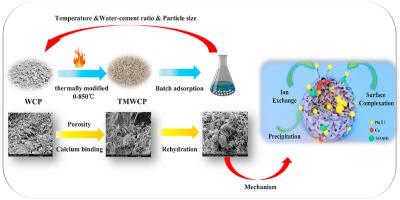Environmental Pollution ( IF 7.6 ) Pub Date : 2021-02-18 , DOI: 10.1016/j.envpol.2021.116776 Zihan Ma , Runze Xue , Jiang-shan Li , Yaqin Zhao , Qiang Xue , Zhen Chen , Qiming Wang , Chi Sun Poon

|
Exploring effective uses of waste concrete powder (WCP), produced from recycling of construction & demolition waste is beneficial to the environment and sustainable development. In this study, WCP was first treated thermally to enhance the ability to remove Pb (II) from aqueous solutions. The experimental results revealed that the thermal treatment could enhance adsorption capacity due to modification of calcium bonding and pore structure of WCP. Preparation parameters such as temperature, particle size, and water-cement ratio were investigated to obtain the optimal operational conditions. Batch adsorption experiments were performed to explore influence factors of pH (1.00–6.00), ionic strength (0.05–2 mol/L), dosage (2–50 g/L), and temperature (25–45 °C). The pseudo-second-order kinetics model could adequately describe the adsorption process, and the Langmuir model was capable to predict the isotherm data well in the low concentration region (C0 < 500 mg/L). The maximum uptake capacity for Pb (II) calculated by Langmuir model at 25, 35 and 45 °C were 46.02, 38.58 and 30.01 mg/g respectively, and the removal rate of Pb (II) was 92.96% at a dosage of 50 g/L (C0 = 1000 mg/L). Precipitation, ion exchange, and surface complexation were identified to be the main mechanisms of Pb (II) adsorption through microscopic investigation by SEM-EDX, XRD, FTIR, XPS, and BET inspections. The study confirms that the WCP after thermal modification, can be selected as a promising adsorbent for the high performance and eco-friendliness.
中文翻译:

使用热改性废混凝土粉去除废水中的Pb(II):效果和机理
探索有效利用废旧建筑废料回收产生的混凝土废粉,有利于环境和可持续发展。在这项研究中,首先对WCP进行了热处理,以增强从水溶液中去除Pb(II)的能力。实验结果表明,热处理可以提高WCP的钙键和孔结构,从而提高吸附能力。研究了温度,粒度和水灰比等制备参数,以获得最佳操作条件。进行了批量吸附实验,以探索影响pH值(1.00–6.00),离子强度(0.05–2 mol / L),剂量(2–50 g / L)和温度(25–45°C)的影响因素。拟二级动力学模型可以充分描述吸附过程,0 <500 mg / L)。由Langmuir模型在25、35和45°C下计算得出的Pb(II)的最大吸收量分别为46.02、38.58和30.01 mg / g,当剂量为50 g时Pb(II)的去除率为92.96%。 / L(C 0 = 1000 mg / L)。通过SEM-EDX,XRD,FTIR,XPS和BET检查进行的显微镜研究,沉淀,离子交换和表面络合被确定为Pb(II)吸附的主要机理。该研究证实,经过热改性的WCP可以被选作具有高性能和生态友好性的有前途的吸附剂。











































 京公网安备 11010802027423号
京公网安备 11010802027423号